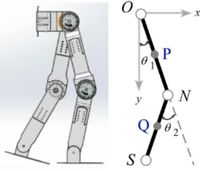The field of rehabilitation robotics is evolving to meet the increasing demand for effective treatment methods as the population ages and the prevalence of lower limb dysfunction rises. Researchers are now directing their focus on Lower Limb Rehabilitation Robotic Systems (LLRRS), which have shown potential in improving rehabilitation outcomes through precise control and feedback mechanisms. A recent paper outlines a novel control strategy aimed at enhancing the consensus tracking performance of these systems amid initial state deviations, offering promising implications for future rehabilitation approaches.
The study begins by acknowledging the limitations of traditional rehabilitation approaches, including insufficient training intensity and variability in effectiveness. With the integration of advanced mechanical designs and intelligent algorithms, lower limb rehabilitation robots can provide an innovative solution to these challenges. The authors developed a comprehensive mathematical model for the LLRRS and introduced a closed-loop PD-type iterative learning control algorithm that incorporates initial state learning. This control scheme alone relies solely on measurable outputs of the system, making it a practical choice for real-world applications.
During their investigations, the authors formulated a series of hypotheses and conducted simulations to validate the effectiveness of their proposed methodology. The iterative learning control system was designed with the specific intent of addressing the significant impact that initial state deviations have on rehabilitation outcomes. Through rigorous mathematical analysis and simulation studies, the researchers demonstrated that their control method could effectively achieve consensus tracking of the robotic system's state variables, ultimately resulting in improved performance.
In the experimental testing phase, the study utilized a prototype of the LLRRS to facilitate real-life evaluations of the control strategy. The findings revealed notable performance metrics; the maximum tracking error for the hip joint angle was found to be 7.14°, while the knee joint angle exhibited a maximum tracking error of 5.74°. These results corroborate the theoretical assessments and highlight the practical applicability of the closed-loop PD-type iterative learning control algorithm.
The researchers also compared their work to existing literature on robotic rehabilitation methodologies. For instance, they referenced the results of previous studies that highlighted similar challenges in ensuring accurate motion tracking in robotic systems. The results indicated that their proposed control scheme resulted in lower trajectory tracking errors, showcasing enhanced robustness in the control of the LLRRS compared to traditional methods.
As the research progressed, the authors aimed for continual improvement in the algorithm's convergence speed. To that end, they designed an exponential variable gain type iterative learning control scheme, further enhancing tracking accuracy. Upon testing, they noted a significant reduction in the convergence time needed to achieve desired outcomes; the new control algorithm converged in nearly half the iterations required by its predecessor. The efficacy of this enhanced control methodology was demonstrated through both simulation and prototype testing, confirming its capacity to perform under dynamic conditions.
While the current study marks a substantial step forward in the field of rehabilitation robotics, the researchers acknowledged certain limitations that warrant attention. The experimental outcomes revealed deviations in joint angles during real-time testing, attributed partly to the complexities associated with three-dimensional motion beyond the presumed sagittal plane. Furthermore, refining system parameters and overcoming the challenges of dynamic modeling remain essential for ongoing enhancements in accuracy and operational smoothness.
Overall, the findings from this study provide a framework for future innovations in robotic rehabilitation technology. By addressing the consensus tracking problem posed by initial state deviations, the new control scheme lays the groundwork for enhancing rehabilitation systems, potentially increasing the adoption of lower limb rehabilitation robots in therapeutic settings. The authors emphasize the significance of their contributions and outline potential future research directions aimed at elevating the performance of rehabilitation robots in practical applications.




